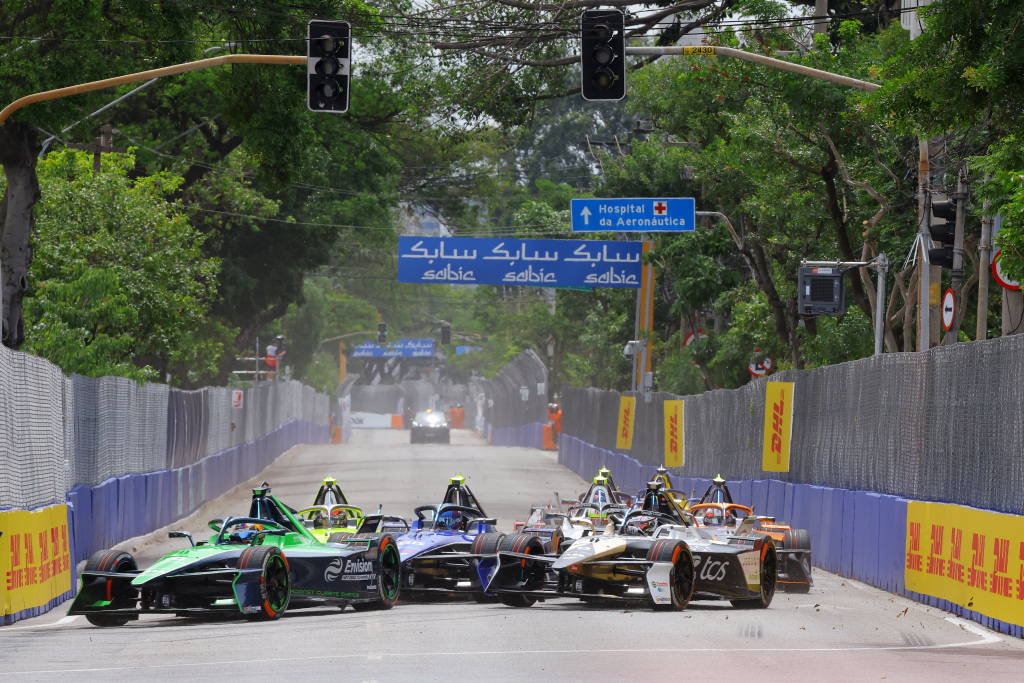Fast charging is a key topic of discussion when it comes to electric vehicles, and when the GEN3 car was introduced two seasons ago, it should have become a key theme in Formula E, too. Now, after a long wait, Pit Boost is finally set to arrive.
Pit Boost will have drivers come in for a 30-second pit stop to top up battery levels by 10 percent at 600kW power. It will provide a key strategy instrument, with drivers already only starting the race with around half the energy they’d need to complete it flat-out. The additional 10 percent will change how the useable energy is deployed in the race, potentially opening the door for more aggressive running, and less energy management — not to mention when you choose to make the stop for the top-up.
It’s that last point that’s proved to be one of the stumbling blocks when it’s come to the introduction of in-race fast charging. Along with typical technical hurdles, the FIA had to work out just how you fit meaningful pit stops into races that are shorter than the other FIA world championships that feature stops.
“In Formula E, we have always been looking to innovate and introduce the most advanced technologies and of course this always comes with challenges,” Pablo Martino, head of Formula E at the FIA, tells RACER. “We have had some challenges from a technical point of view that have required further validation testing to happen before the introduction of this Pit Boost in Season 11. We have also had some sporting challenges because of course it’s not easy in a 45-minute (race) to use a pit stop; but we are ready to move forward and introduce this new technology in Formula E.”
It won’t be at every race, though. Pit Boost charging will feature at doubleheader events — and in only one of the two races on those weekends, too — in a deliberate move to provide variety in terms of race types and strategies over the course of the season.
“This has been a decision that was taken at the beginning of the project,” Martino explains. “Basically, Formula E races have no need to have this extra energy; however, we believe that the Pit Boost will create an additional strategy element. Races with this 10 percent extra energy are going to be totally different to the races without the Pit Boost.”
 Choosing the right window for Fast Charge will open a new strategic element for Formula E’s frenetic races. Motorsport Images
Choosing the right window for Fast Charge will open a new strategic element for Formula E’s frenetic races. Motorsport Images
The technology for Pit Boost differs to the current charging infrastructure in Formula E. Already, an 80 kW charger provided by series partner ABB charges the cars from zero to 100 percent using power from the local power grid at races. The pit booster comes from Fortescue zero (previously known as Williams Advanced Engineering) and is designed to provide 10 percent of the car’s battery capacity in a fast 600kW boost. The pit boosters are not connected to the local grid at all times either, storing the energy they put into the cars in a battery.
Now that the technology has arrived, the development won’t stop. While Formula E has just introduced its updated GEN3 Evo, work on the GEN4 car that will succeed it in 2026 is ongoing. While wholesale changes aren’t anticipated, lessons learned over the next two years will be implemented when GEN4 arrives.
“We are always trying to think six, seven years ahead of the mass production technologies, so of course we are now in the process of finalizing the definitions of the GEN4 project,” says Martino. “On the car side it’s already quite defined. We are still working with different charger suppliers in order to determine who will be the charger producer for GEN4. Of course, depending on the choice we take, the technology will be a little bit different.
“That doesn’t mean that we are going to change the technology radically. We still consider the 600 kW Pit Boosters are going to continue being at the front in terms of technology in a couple of years’ time when the GEN4 is introduced, but of course any of the learnings from these upcoming two seasons will be implemented sporting-wise in Season 13 onwards.”
 As it evolves its own fast charging systems, Formula E hopes to help propel the technology forward for road-going electric cars. Sam Bagnall/Motorsport Images
As it evolves its own fast charging systems, Formula E hopes to help propel the technology forward for road-going electric cars. Sam Bagnall/Motorsport Images
Road relevance is a big part of Formula E, and while current roadside charging technology differs from what Formula E is bringing in, Martino believes we could see crossover within the next half-decade, although he acknowledges that it will be a big undertaking.
“Today, with road car technology, the fastest chargers are operating at 350 kW, which is already a really big amount of power, but the technology behind them is quite different,” he says. “The road relevancy is super-important for us as a championship, but also the manufacturers involved in the championship, so from their side, they always work on how to make races more relevant for the street cars for the road. We, as the FIA, on the technical side and also on the sporting side, also work with that objective in mind.
“We hope to see, in the next five years, similar power capacities for the street. That will probably be a turning point for the charging infrastructure but of course it’s quite technologically demanding, so it’s something that is a little bit complex to see.
“But the technology is there, not only with the chargers, but the batteries. One of the biggest challenges for the Pit Boost is to have batteries capable of working with 600 kW power, so this technology is quite demanding and complex to implement. But we foresee that its implementation on the streets will continue evolving at the same pace that it’s evolving today.”
The first chance to see Formula E’s Pit Boost in action will be at the Jeddah E-Prix in Saudi Arabia on Feb. 14-15. Before that, the season continues in Mexico City on Jan. 11.









